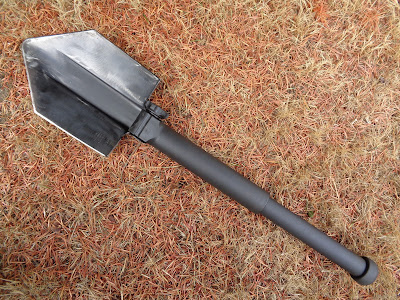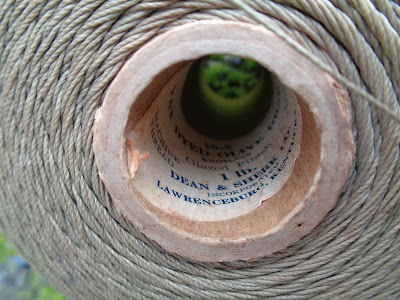I have been working on filling the various holes in the "Modern Shovels" section of the collection, and I have had one VERY difficult shovel to find (at least here in the US). I have needed a Glock folding shovel. Not just any Glock shovel, but one that was actually issued to the Danish Army.
Well I finally found one! I noticed that one of my favorite surplus sources in Finland had a batch of Glock shovels that were all surplus, and carried the official markings of the Danish Army. Just what I had been looking for!
Glock has been making and selling their version of the "military grade" folding shovel for 25 years. They are widely available in sporting goods stores, in nearly every country. 99.9% of these shovels are "Civilian" models, and carry no military markings. There are a few ex-military Glock shovels out there, but they are quite hard to find these days.
In 1996, The Danish Army adopted the Glock shovel as their official issue entrenching tool. They were given the classification of Feltspade M/96. The shovels that Glock supplied to Denmark were the same as their civilian shovels, with only one difference. They were stamped with "Danmark M/96" on the blade, below the civilian markings. Aside from that detail, the civilian shovels are exactly the same.
In the last few years, Denmark surplussed what appears to be the entire "first issue" inventory of their Glock shovels. I'm not sure if that means they have adopted another shovel style, or if Glock is continuing to supply their shovels to the Danish Army. I need to do some more research in that direction.
Before we get into the details of these shovels, I think I'll just put my own personal opinion on these shovels out there. I have handled all kinds of entrenching tools, from nearly every army, and from nearly every era, and I can say, that in my opinion, these Glock shovels fall far short of "military grade". They are not very heavy duty, and do not appear that they are built for anything more than casual, moderate digging. I think that might be why only one country has adopted them in all the years that they have been on the market. Basically they feel "cheap", and less-than heavy-duty. Of course this is only my opinion, but if you pick one of these up for true field work, you've been warned!
With all of that out of the way, let's get on to the details.
The blade is stamped from a single piece of steel. There are no other blade parts. There is not a hinge-reinforcement mount riveted or welded on, just two tabs folded up with holes punched as the hinge.
The handle is completely made of black, polymer plastic. I am not sure if it is the same material that Glock uses for their pistol frames, or if it is just similar in appearance. The first section of the handle has the Glock trademark, and "Austria", stamped on one side, and a US patent number on the other side (US.Pat. 4.475.757).
The handle is a two-part, telescoping arrangement. The second section pulls out and by twisting it counterclockwise, you can "firm-it-up", but not mechanically lock it in place.
There is a single pin that goes through the handle end and the blade hinge holes. There is a plastic, threaded tightener knob that is attached to one end of the hinge pin by means of a screw. The knob is used to lock the blade in it's various positions.
There are four positions that the blade can be locked at. Each position is determined by a groove in the handle end, that matches a raised ridge on the blade. The positions are: Fully Closed, Fully Open, Open to a 25% angle (approximately), and a 45% angle (approximately).
There is a threaded end cap on the end of the second section of the handle. When the ring-cap is unscrewed, you can remove a saw blade that is stored inside.
The saw blade is installed by reinserting it into the end of the handle, sliding the tighter ring over it, and then screwing it down tight.
The saw blade is a "push saw" blade, and I believe it was designed to cut roots when digging, and was not really intended as a wood saw. The end of the saw blade is shaped into a flat blade screwdriver.
The screwdriver end of the saw blade is used to remove the screw that secures the tightening knob, or to adjust it's tension.
The saw blade is also meant to be a leverage tool to loosen the tightening knob if it becomes stuck from over tightening. To use it to break free the knob, it is placed into the two slots on the knob and then torque is applied. The flip side of this would be to use the blade to tighten the knob down extra tight, for "military grade digging".
The Danish Army issues these shovels in a plastic "sleeve" that looks like one of the US-NATO style, plastic, tri-fold shovel carriers, but without any attachment clips, loops, etc., on the back. The Danish web equipment system has a "half-pouch" that is the same type as the UK uses. The shovel is placed into the plastic sleeve, then into the belt carrier. I have my eyes out for one of these sleeves and carriers........there is always something to look for! Here are a few excerpts from the Danish manual showing both the shovel and the carrier pouch.
If you can't find one of the Danish Army sleeves and carrying pouches, then you can use one of the current US entrenching tool pouches, designed for the Gerber shovels. The Glock shovel fits it perfectly.
As I uncover more information on these Model 96, Danish shovels (aka, Glock shovels), I'll post updates here on this blog post, so check back if you are interested.
Now let's take a closer look at this shovel.




















































